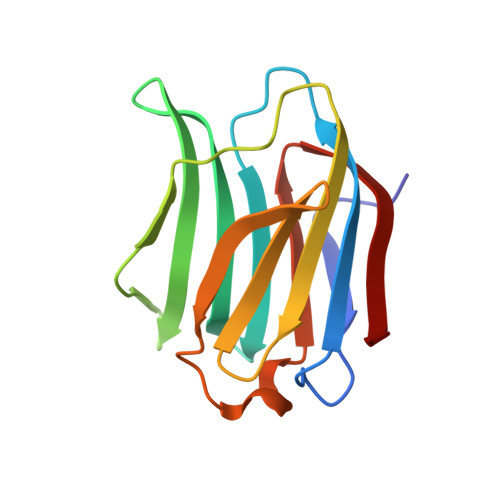Interplay between Conformational Entropy and Solvation Entropy in Protein-Ligand Binding.
Verteramo, M.L., Stenstrom, O., Ignjatovic, M.M., Caldararu, O., Olsson, M.A., Manzoni, F., Leffler, H., Oksanen, E., Logan, D.T., Nilsson, U.J., Ryde, U., Akke, M.(2019) J Am Chem Soc 141: 2012-2026
- PubMed: 30618244
- DOI: https://doi.org/10.1021/jacs.8b11099
- Primary Citation of Related Structures:
6QGE, 6QGF - PubMed Abstract:
Understanding the driving forces underlying molecular recognition is of fundamental importance in chemistry and biology. The challenge is to unravel the binding thermodynamics into separate contributions and to interpret these in molecular terms. Entropic contributions to the free energy of binding are particularly difficult to assess in this regard. Here we pinpoint the molecular determinants underlying differences in ligand affinity to the carbohydrate recognition domain of galectin-3, using a combination of isothermal titration calorimetry, X-ray crystallography, NMR relaxation, and molecular dynamics simulations followed by conformational entropy and grid inhomogeneous solvation theory (GIST) analyses. Using a pair of diastereomeric ligands that have essentially identical chemical potential in the unbound state, we reduced the problem of dissecting the thermodynamics to a comparison of the two protein-ligand complexes. While the free energies of binding are nearly equal for the R and S diastereomers, greater differences are observed for the enthalpy and entropy, which consequently exhibit compensatory behavior, ΔΔ H°(R - S) = -5 ± 1 kJ/mol and - TΔΔ S°(R - S) = 3 ± 1 kJ/mol. NMR relaxation experiments and molecular dynamics simulations indicate that the protein in complex with the S-stereoisomer has greater conformational entropy than in the R-complex. GIST calculations reveal additional, but smaller, contributions from solvation entropy, again in favor of the S-complex. Thus, conformational entropy apparently dominates over solvation entropy in dictating the difference in the overall entropy of binding. This case highlights an interplay between conformational entropy and solvation entropy, pointing to both opportunities and challenges in drug design.
Organizational Affiliation:
Centre for Analysis and Synthesis, Department of Chemistry , Lund University , 221 00 Lund , Sweden.















